Caring for tetrastigma at home
Lighting. The plant grows well in bright, diffused light. The illumination level should be in the range of 3000 - 5000 lux. It can grow under artificial light, but in shaded places, with insufficient lighting, it practically does not give young shoots, and those that appear quickly die off.
Do not allow direct sunlight to fall on the leaves. This can cause both burns and drying of the leaf blade.
Temperature. In order for the tetrastigma to feel comfortable, the summer temperature should be in the range of 20 - 27 ° C. In winter, it is recommended to lower the temperature to 13 - 18 ° C if possible. At lower temperatures, the vine can freeze and lose its leaves. Or, the appearance of brown spots on the surface of the sheet may be observed.
When placed indoors, you should find a place where the plant will not get winter frosty air when ventilated and which will be located far from the heaters.
Watering. During the growing season, Tetrastigma Vuanye is watered abundantly, as the topsoil dries up. At the same time, well-settled soft water, without chlorine impurities, is used for irrigation. In winter, at low air temperatures, watering is reduced, preventing the substrate from drying out.
Air humidity. Indoor grapes tolerate dry indoor air well, but, nevertheless, it is recommended to spray it periodically, since in conditions of high humidity it feels more comfortable.
The soil. The soil for the plant should be well-drained, slightly acidic or neutral, with a pH reaction of 5.5 - 6.5. Any ready-made soil for lianas is suitable for growing tetrastigma, but if there is a desire and the ability to compose a soil mixture on your own, it is recommended to take peat, turf, humus and sand in equal parts.
Transplant, top dressing. The young plant is transplanted annually. An adult can be difficult to transplant because of its size. Therefore, for an adult plant, a large pot or tub is immediately selected, and in the future, only the top layer of the soil is changed.
Given the impossibility of transplanting, Vuanye's Tetrastigma must often be fed with mineral and organic fertilizers. In winter, top dressing is done every two to three weeks. During the growing season, they are fed weekly.
Formation. Given the rapid growth of the plant and the lignification of the trunks, it is necessary to monitor the formation of young shoots, attaching them to the support, twisting them around the trellises or guiding them along the strings along the ceiling. If you skip the stage when the plant can still be given the desired shape, then in the future it will only be possible to cut it off and wait for the appearance of new shoots.
You can trim and pinch the tetrastigma several times throughout the year.
Reproduction. This vine propagates by cuttings at any time of the year. For rooting, ripe parts of the stem with one or two nodes are selected. When planting, the node must be above the ground. You can also wait for the roots to appear by placing the cuttings in water.
Tetrastigma: description and characteristics
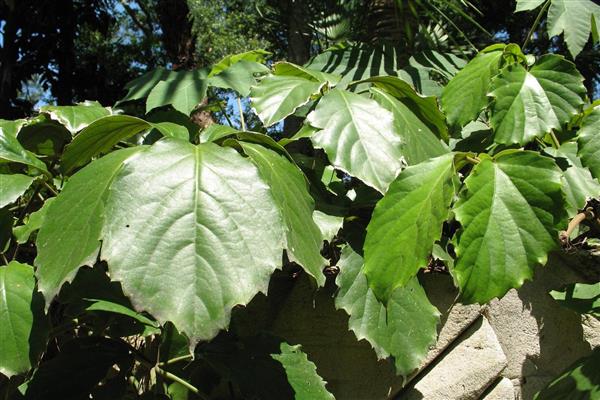
Tetrastigma: photo
In today's article we will tell you about an amazing plant, about tetrastigma. This culture belongs to the Vinogradovs. There are more than 100 species in the genus; in its natural habitat, tetrastigma is found on different continents. However, in indoor conditions, this plant is very often grown as a home grape. Therefore, in your apartment, you can easily grow this beautiful liana. The foliage of the tetrastigmus is quite large, the shape is lobed.In its natural habitat, this plant is found, as we noted earlier, on different continents.
Moreover, it is important to note that in natural conditions it grows very intensively. Shoots in length reach tens of meters
Flowers are not particularly appreciated, indoor plants are grown in order to decorate your home with exotic vines. It is best, however, to shorten the shoots to one meter or 2-3 meters. Tetrastigma recovers very quickly, therefore, under favorable growing conditions, these vines can increase in length by almost 1 m per year.
Tetrastigma Vuagnier - home care, photo

Tetrastigma Vuagnier in the genus Tetrastigma of the family Grape, a popular indoor grape, is a popular vine for spacious rooms. A climbing plant with an openwork emerald crown always comes in handy if you need to green a dull corner of the interior in a short time. In a small apartment, you will have to trim it often enough to hold back growth.
The genus consists of 90 species, found mainly in the south and southeast of Asia, only one is found in northern Australia. However, no more than 2-3 species are used as ornamental houseplants. The most common in the collections of domestic florists is the Vuagnier tetrastigma, named after the French veterinarian M. Voinier, who first discovered the climbing perennial in Laos or North Vietnam.
Vine appearance

In nature, the plant is a fast-growing liana with a branched rhizome and dark green or bluish pagons, the length of which sometimes reaches 50 m, but at home it grows stems only up to 3-4 m.
Finger leaves, with 3, 5 or 7 lobes, arranged alternately along the pagons on long petioles. Each lobe has jagged edges and a pointed tip, its rich emerald surface is covered with expressive veins. The underside of the leaf blades is covered with short reddish-brown villi and dotted with light dots of miniature sap-secreting glands, which are often mistaken for some kind of pest. Antennae are located along the pagon, with the help of which the stems seek support for growth.
Flowers in the Vuagnier tetrastigma form in the axils of the leaves, forming umbellate inflorescences. Tubular corollas are painted yellow or light green, from their center peeps out a 4-spatulate stigma, which gave the name to all plants of the genus: translated from Latin tetra - "four", and stygma - "stigma". In indoor conditions, the liana blooms very rarely, but it adds in growth in one season from 60 to 100 cm.
Caring for tetrastigma at home
Even an inexperienced florist can easily grow tetrastigma in his home. This liana is distinguished by its unpretentiousness, but still there are certain features in its cultivation.
Illumination
Tetrastigma refers to light-loving plants that need a lot of light. The light needs to be bright, but it must be necessarily diffused, because due to direct rays hitting the sheet plates, burns can form on them.
Temperature regime
In the warm season, the vine needs warmth (the temperature should not drop below 23 degrees). In winter, she needs coolness (from 15 to 17 degrees), but make sure that the room is not colder than 12 degrees, because this can cause the bush to begin to throw off the foliage. Drafts can also harm the plant.
Watering and humidity
Tetrastigma grows normally at a low level of humidity, which is typical for living rooms. However, it is still recommended to moisten its foliage once a week from a spray bottle, but only if the bush is warm. With a cool winter, you do not need to moisten the foliage.
You should choose a watering mode that completely eliminates the drying out of the clod of earth in the pot. In the spring-summer period, on average, the vine is watered 2 times a week.With a cool winter, the number of waterings is reduced to two per month, while it must be borne in mind that the soil mixture in the pot should be a little damp all the time.
Suitable substrate
For planting indoor grapes, a loose soil mixture saturated with nutrients is suitable, while it can be slightly acidic or neutral. In order to make a suitable soil mixture, you should combine garden, sod and deciduous soil, and also perlite (1: 2: 2: 2). Also, at the bottom of the pot, which must have holes, you need to make a good drainage layer.
Top dressing
The liana is fed only during the growing season, which is observed in spring and summer. Fertilizers are applied to the substrate at intervals of 2 times a month. In the event that the growth of the bush is very fast, then the frequency of feeding can be increased up to 1 time in 7 days. For this, experts advise using organic matter and complex mineral fertilizers.
Transfer
During the first two years, when the growth of the vine is most intense, it will have to be transplanted several times a year. Older specimens are subjected to this procedure systematically once a year. Tetrastigma tolerates transplantation quite well. The new container should be taken a couple of times larger than the old one. After the bush is planted in a tub, reaching more than 30 centimeters in diameter, it becomes very difficult to transplant, in this case it is recommended to systematically replace the three centimeter top layer with fresh soil mixture.
Pruning
There is no particular need to trim the vine. But if you carry out pruning, then the tetrastigma will transfer it well. When the bush grows up, it will have to be cut in order to contain growth. However, remember that you should never touch the young foliage with your hands, as well as cut it off, because there is a possibility that it will fall off along with part of the shoot. The grown flower needs support, but it is recommended to install it in advance.
How to propagate by cuttings
Indoor tetrastigma can be easily propagated by cuttings. The tops of the stems are used as cuttings, on which there should be one bud and two grown leaf plates. The lower cut is treated with a solution of the drug, which enhances root growth. For rooting, cuttings are planted in a mixture of sand and peat, or they are placed in a glass of water. In order for rooting to go faster, the container with cuttings on top should be covered with a film, while the air temperature should be about 24 degrees. Rooted shoots are planted in a pot filled with soil mixture, suitable for growing adult vines.
Diseases and pests
In a room with dry air, it can be affected by spider mites. If the plant is small, to fight the pest, it is washed under a hot shower (water temperature is about 40 ° C). If this cannot be done, the affected plant must be treated with an appropriate insecticide.
Also indoor grapes are affected by the felt. It can be identified by a fluffy white coating that can be easily removed with a brush or cotton swab. In case of severe damage, it is recommended to treat the plant with an insecticide of the appropriate action.
Of the diseases, tetrastigma is mainly susceptible to diseases of "improper care". For example, in the case of a lack of nutrients in the plant, the leaves may turn yellow and fall off. The same will be observed when watering with hard, chlorinated water.
Of the pests, the plant is most often attacked by spider mites. These pests appear on liana due to low air humidity. Insects can be recognized by the thin, sticky cobwebs and whitish bloom that they leave on the stems of the crop. To get rid of ticks, give the flower a warm shower with a water temperature of 40 degrees. If this does not help, then treat the plant with an insecticide, for example, "Aktara" or "Aktellik".
In addition, in case of violation of the norms of agricultural technology with a vine, the following problems arise:
- Pulling shoots. Lack of light leads to this. Move the vine to a lighted place.
- Brown spots appeared on the leaves. Similar damage appears if the plant is exposed to direct sunlight. In addition, growing in a room that is too cold can lead to brown spots. Correct the situation depending on the reason.
- The leaves are covered with yellow spots. Watering with hard water leads to a similar phenomenon.

In the dry air of apartments, the Vuagnier tetrastigma is trapped by pests typical for most decorative leafy plants. These include felt, spider mites and scale insects. If you notice drooping leaves, brown spots or sticky deposits on the petioles, immediately start fighting the parasites.
The affected leaves are washed with water, all visible pests are removed with a cotton swab. Then the plant must be treated with an insecticide solution. In the case of a deep lesion, the treatment must be carried out twice.
Indoor grapes are disease resistant. It is almost not affected by viruses, subject to the temperature regime and proper watering, the tetrastigma is not afraid of gray rot and black leg.
Withering of leaves or stretching of stems occurs when overflowing or stagnant water in the pan, as well as, when there is a lack of bright lighting. To eliminate these undesirable reactions, it is necessary to adjust the watering and air temperature.
Tetrastigma does not tolerate poor nutrition. If the plant is not fed, then the edges of the leaves begin to turn black, the leaf decreases, the number of leaf lobes may decrease, it loses its decorative effect and falls off.
Against this background, Vuagnier's Tetrastigma can be damaged by thrips, spider mites and aphids. For protection, drugs of biological or chemical origin are used.
For the most curious, we suggest that you familiarize yourself with the video about Tetrastigma
Tags: agricultural technician, voanie, description, application, plant, tetrastigma
About the author: admin4ik
Tetrastigma Vuanye: description, home care rules (8 photos)
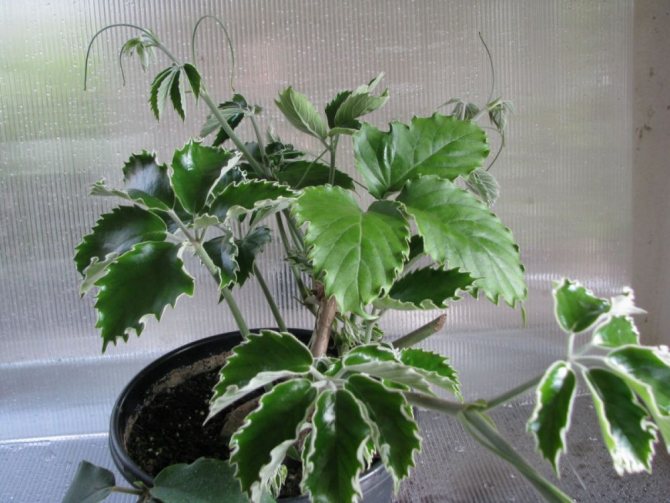
Description

Home care
- regular watering;
- periodic feeding;
- planned transplant;
- pruning;
- prevention of diseases and pests.
Lighting Tetrastigma Vuanye is a photophilous plant, but direct sunlight is contraindicated for it, because from them the leaves of the flower get burns. Therefore, it is advisable to grow home grapes near the east or west window. Yes, you can put the pot on the southern windowsill, but here you need to remember to shade the plant at noon.
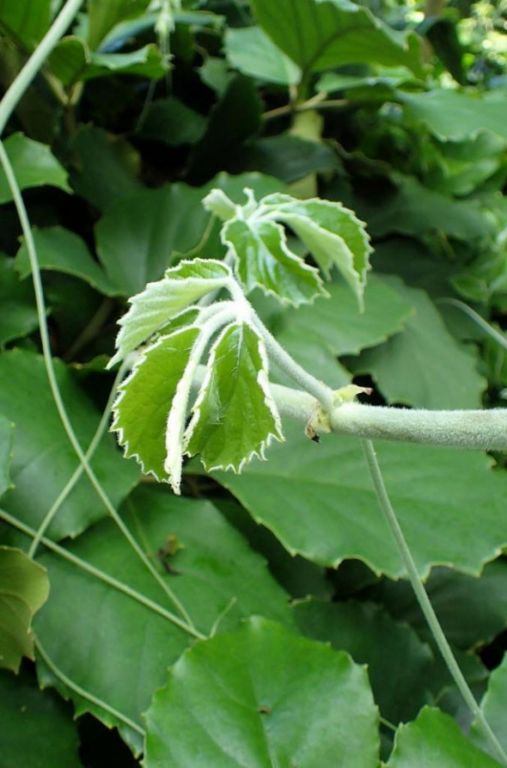
Temperature This ornamental plant for the home belongs to heat-loving crops. And from spring to autumn, it is desirable to maintain the indoor temperature within + 23 ... + 27 ° C. In the summer, you can take the plant out to the balcony or in the garden, but it is worth choosing places for it where the direct rays of the sun or sharp gusts of wind do not reach. In winter, grapes require cooler conditions (+ 15 ... + 17 ° C)
But it is important to remember that lowering the temperature to +12 ° C will be critical for the flower. And in such cold weather it will quickly freeze and die. Watering and air humidity Home grapes are a very moisture-loving plant
And in order for home grapes to please with lush foliage, it is important not to allow the soil to dry out, and to moisten the soil as soon as it dries to a depth of 1-2 cm. Experienced growers recommend growing liana in special pots for indoor plants with automatic watering. This approach greatly reduces the risk of overdrying the earth ball.
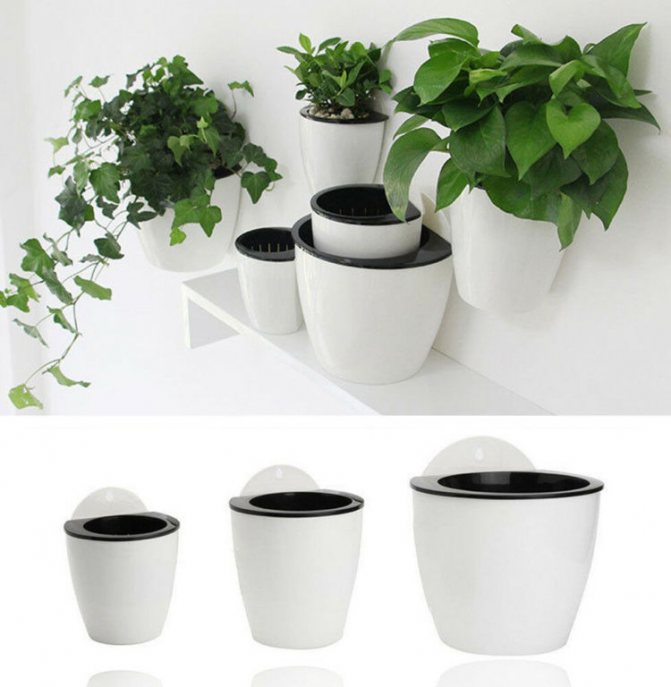

Top dressing Vuanye's tetrastigma responds well to feeding. And it is advisable to fertilize home grapes every two weeks from spring to autumn. For these purposes, use complex mineral formulations. And also sometimes spoil the vine with organic matter, for example, green fertilizer. In winter, the plant begins a dormant period, at which time it does not need feeding.
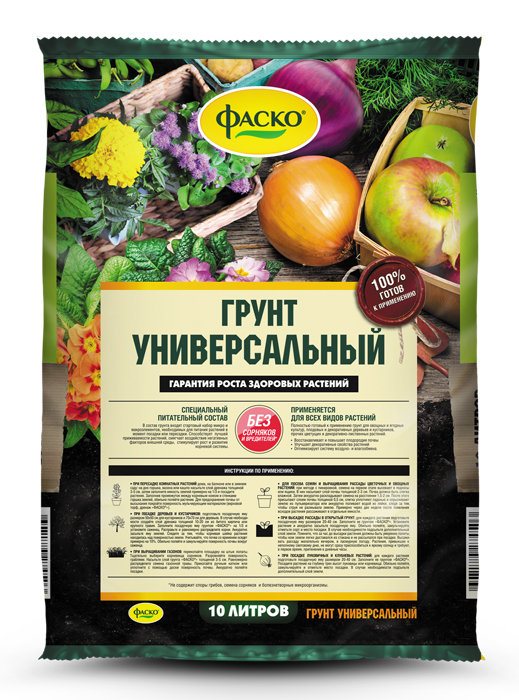
Transfer Young homemade grapes grow rapidly and will have to be replanted 1-2 times a year during the first two years. For adults, it is advisable to hold this event every spring. But if you have large grapes that are difficult to transplant, then annually change the topsoil to a depth of 3 cm. For plants, choose stable pots, one size larger than the previous ones. As for the soil, for indoor grapes, an ordinary store-bought mixture intended for decorative deciduous crops is suitable. An excellent option would be Fasco soil. If you want to create a substrate yourself, then mix the following components in equal parts:
- sod soil;
- leafy land;
- compost;
- river sand;
- peat.
Before transplanting, be sure to disinfect the substrate by baking it in the oven or holding it over steam. Otherwise, the plant will die from microorganisms that live in the soil. In addition, do not forget to pour a thick layer of drainage on the bottom of the new container, for example, expanded clay, pebbles, brick chips. The transplantation procedure itself is carried out by the transshipment method.

Trimming and supportingReproduction

Diseases and pests Vuanye's tetrastigma is a plant with strong immunity, and at home it almost never gets sick. But if you regularly make mistakes in care, then the strength of the vine will be depleted, and it will become vulnerable to microorganisms and parasites. Of the pests, the plant is most often attacked by spider mites. These pests appear on liana due to low air humidity. Insects can be recognized by the thin, sticky cobwebs and whitish bloom that they leave on the stems of the crop. To get rid of ticks, give the flower a warm shower with a water temperature of 40 degrees. If this does not help, then treat the plant with an insecticide, for example, "Aktara" or "Aktellik". In addition, in case of violation of the norms of agricultural technology with a vine, the following problems arise:
- Pulling shoots. Lack of light leads to this. Move the vine to a lighted place.
- Brown spots appeared on the leaves. Similar damage appears if the plant is exposed to direct sunlight. In addition, growing in a room that is too cold can lead to brown spots. Correct the situation depending on the reason.
- The leaves are covered with yellow spots. Watering with hard water leads to a similar phenomenon.
When choosing an ornamental plant for your home, pay attention to tetrastigma. This attractive vine will adorn any room, and even an inexperienced florist can grow it.
The main thing is to adhere to the rules of care, and clearly carry out all agrotechnical measures, and then the culture will delight for a long time with its impeccable appearance. Material taken: Here
3. Varieties:
3.1. Tetrastigma Voinier - Tetrastigma voinierianum
A fast growing evergreen liana with woody stems up to 9 m long. The leaves are dark green, glossy, compound - they consist of 3 - 5 broadly lanceolate segments. The leaf blades have large denticles at the edges and are often colored in a lighter shade on the lower surface. Young shoots and the lower surface of the leaves are covered with a small, delicate pubescence. Small greenish flowers appear in early summer in a branched inflorescence - a brush. Flowering is of little interest.
This variety is most commonly found in indoor culture.

3.2. Tetrastigma lanceolate - Tetrastigma lanceolarium
A large evergreen vine with flexible stems reaching 18 m in length. With age, the stems become lignified and covered with brown bark. Leaves on long petioles, compound - consist of 3 - 5 oblong - lanceolate segments. Young leaves have a reddish-bronze tint. Segments are dark green, glossy, with poorly pronounced denticles along the edge. The flowers are axillary, yellowish green, inconspicuous, collected in small axillary racemes. Over time, the flowers turn into small, rounded berries.

You may also be interested in:
Cissus
Asparagus
Syngonium
Fatshedera
About caring for Tetrastigma:
Temperature: The optimum temperature for Tetrastigma in summer is 20-27 ° C, while in winter the temperature should not drop below 12 ºC. The plant does not like sweltering heat and high temperatures in summer. In winter, it will grow well at a temperature of 12 ° C, therefore, it is most often grown in rooms where they are least heated. Tetrastigma is characterized by increased adaptability, therefore, if it still fails to arrange a lower temperature in winter, it will have to be compensated for by other procedures. It is unacceptable to place the plant near heating devices or under the cold air currents of an air conditioner. The plant tolerates drafts well, but only if they are warm. In winter, it is necessary to exclude any exposure to frosty air. In summer, Tetrastigma will not refuse to spend time outdoors in the shade or partial shade of trees.
 Tetrastigma leucostaphylum.
Tetrastigma leucostaphylum.
Lighting: Tetrastigma needs soft diffused lighting and does not tolerate direct sunlight, this is fraught with leaf burns. A western or eastern window sill will suit him well, a northern one is a good option. Tetrastigma is shade-tolerant and can be easily placed at some distance from windows. In general, the plant is not particularly whimsical in terms of illumination and gives complete freedom of action in choosing a place of growth. The plant responds to favorable conditions of the place of growth with rapid development, bright color and large leaves.
Watering: Regular and abundant. It is necessary to water with soft, settled water, it is not permissible to use tap water, as this affects the beauty of the leaves. The water should be at room temperature or warmer. Watering with cold water, even once, can cause foliage to fall. Watering frequency depends on the temperature of the content. The water should not stagnate in the pot, but at the same time it should be constantly moist. It is necessary to constantly monitor the degree of soil drying, and watering should be done when the top layer dries out by 1-2 cm. After each watering, it is necessary to loosen the soil or at intervals of 1 time in 2-3 weeks. After watering, the water from the pallet must be drained. If in winter the temperature in the room is low, it is necessary to reduce watering and maintain a slight moisture content of the substrate, but if Tetrastigma is warm, watering is not reduced and is carried out in the same way as in summer, when the topsoil dries out by 1-2 cm.
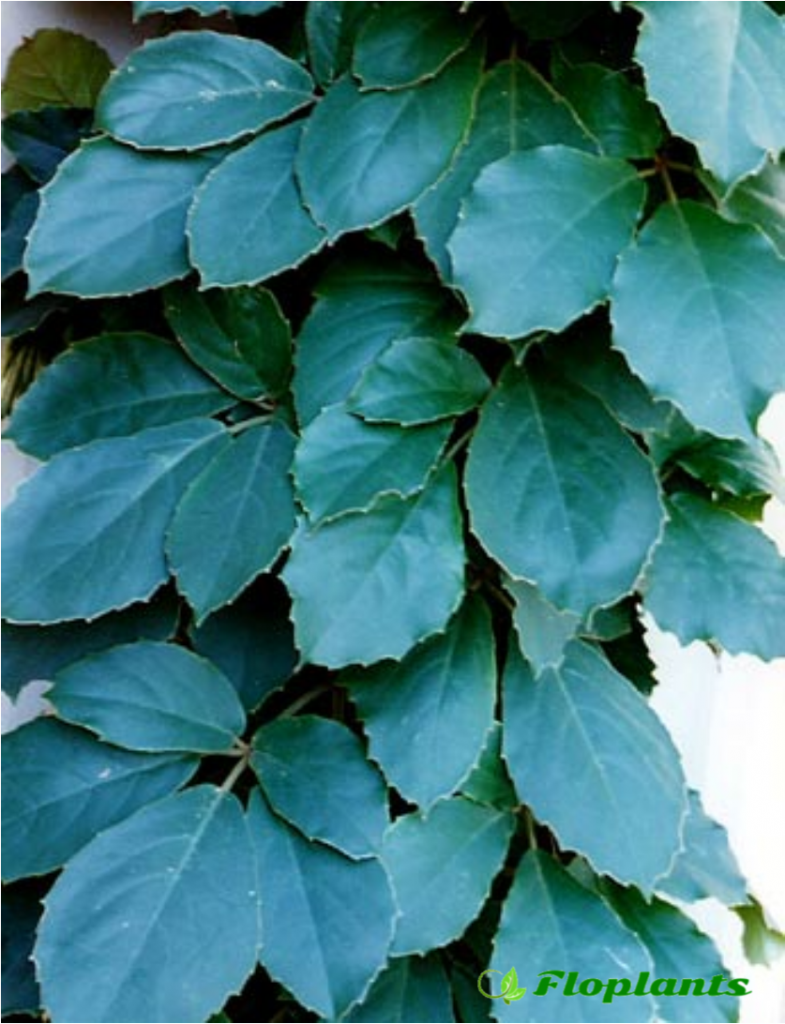 Tetrastigma voinierianum.
Tetrastigma voinierianum.
Air humidity: Liana is not particularly picky in terms of air humidity. It responds well to both high humidity and dryness. For better plant well-being, light spraying of the leaves can be carried out. Spraying in the heat has a beneficial effect on the plant. In winter, if the plant is kept warm, it is necessary to compensate for this with increased humidity and water procedures should be frequent and regular. It is necessary to clean the leaves from dust and periodically arrange a shower for the plant. The use of leaf shine sprays is not recommended.
Crown shaping: Tetrastigma responds well to shaping, which can be done by pruning or pinching to shape. During the transplantation of the plant, it is necessary to inspect the shoots and remove the old, thinned, bare up to hemp.
For growing Terastigma, it is recommended to use rigid supports in the form of ladders, semicircles and trellises. Green walls and screens are created by garters and pruning from this plant.
Fertilizers: It is necessary to fertilize during the period of active growth from spring to autumn once a month with fertilizer for decorative deciduous plants in a half dose. In the fall, all fertilization is stopped.
 Tetrastigma leucostaphylum.
Tetrastigma leucostaphylum.
Soil: Should be light, loose and nutritious. Suitable soil for decorative deciduous plants, a universal substrate. Good drainage is required at the bottom of the pot.It is recommended to add perlite and charcoal to the substrate.
Transplant: A young specimen is transplanted only when necessary, when the roots have completely mastered the earthen lump. Large plants can be transplanted into a larger pot every 3-4 years. The pot is selected high and wide, about 3-4 cm larger than the previous one. The support is installed before planting the plant itself. After transplanting, the plant needs adaptation, it is placed in a shaded place for 2-3 days and is not fertilized for a month. If the transplant is not carried out, it is necessary to change the topsoil annually.
Pests of Tetrastigma. Not susceptible to pests, but if kept too dry, the plant can be attacked by spider mites and aphids.
Soil and fertilizers
... The soil for the plant should be well-drained, slightly acidic or neutral, with a pH reaction of 5.5 - 6.5. Any ready-made soil for lianas is suitable for growing tetrastigma, but if there is a desire and the ability to compose a soil mixture on your own, it is recommended to take peat, turf, humus and sand in equal parts.
Vuagnier grapes look very good in a wide bowl. For this, large pots, baskets or decorative barrels are selected. Young plants are transplanted every year. After reaching the five-year milestone of Tetrastigma Vuagnier, you can completely renew the soil once every four years.
At the same time, the topsoil is refreshed annually. It should have the qualities of fertility, high density, be neutral or slightly acidic relative to the acidity index.
The earth mixture consists of the following components:
-
- sod land (3 parts);
- deciduous land (1 part);
- humus earth (1 part);
- sand (1 part).
Fertilizing the Vuanye Grapes is necessary in the spring-summer period twice a month. To do this, use mineral or universal organic fertilizers in a dosage according to the manufacturer's recommendations.
Growing problems
Homemade grapes are considered an unpretentious plant, but with errors in care, flower growers may face problems.
- Due to the lack of lighting, the shoots are stretched, and the crown turns pale. In winter, the flower can be placed under a phytolamp or fluorescent lamp.
- When the temperature drops, the grapes shed their leaves. The situation will be corrected by rearranging the pots with a flower in conditions comfortable for this culture.
- In the absence of top dressing or due to improperly selected soil, the leaves turn black, become small, the number of lobes on one petiole decreases.
- Dry indoor air leads to the appearance of spider mites. The symptom of the disease is drying of the crown, a powdery coating on the leaves and a small cobweb between the shoots. In the initial stages of the disease, a warm shower and changes in conditions of detention help. In advanced cases, insecticides are used.
- Violation of the rules of care leads to infection with a mealybug. The pest leaves a characteristic white bloom on the leaf. To combat, use an infusion of tobacco, garlic, calendula, or chemical insecticides. Each sheet must be gently wiped with a cloth dampened in the solution.

Shaping and pruning
Pruned in spring or late winter. In young plants, lashes are pinched to enhance branching. In adult plants, shoots that are too long are cut to the bud next to the mother branch. It is recommended to remove weak shoots, to reduce the density of the bush. Excessive density leads to crushing of the leaves. Pruning rejuvenates old bushes. All lashes are cut to a meter. Cut shoots are not thrown away - they are used for cutting cuttings.
The support is used strong, reliable - it should easily support the weight of an adult liana. Ready-made plastic nets or taut cords will do. Tying young lashes to the support, they set the direction of growth, create the necessary shape.


